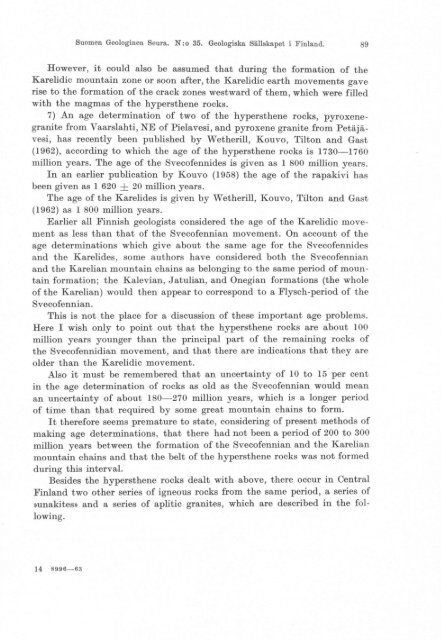COMMISSION GEOLOGIOUE - Arkisto.gsf.fi
COMMISSION GEOLOGIOUE - Arkisto.gsf.fi
COMMISSION GEOLOGIOUE - Arkisto.gsf.fi
Create successful ePaper yourself
Turn your PDF publications into a flip-book with our unique Google optimized e-Paper software.
Suomen Geologinen Seura. N: 0 35. Geologiska Sällskapet i Finland. 89<br />
However, it could also be assumed that during the formation of the<br />
Karelidic mountain zone or soon after, the Karelidic earth movements gave<br />
rise to the formation of the crack zones westward of them, which were <strong>fi</strong>lled<br />
with the magmas of the hypersthene rocks.<br />
7) An age determination of two of the hypersthene rocks, pyroxenegranite<br />
from Vaarslahti, NE of Pielavesi, and pyroxene granite from Petäjävesi,<br />
has recently been published by Wetherill, Kouvo, Tilton and Gast<br />
(1962), according to which the age of the hypersthene rocks is 1730-1760<br />
million years. The age of the Svecofennides is given as 1 800 million years.<br />
In an earlier publication by Kouvo (1958) the age of the rapakivi has<br />
been given as 1 620 ± 20 million years.<br />
The age of the Karelides is given by Wetherill, Kouvo, Tilton and Gast<br />
(1962) as 1 800 million years.<br />
Earlier all Finnish geologists considered the age of the Karelidic movement<br />
as less than that of the Svecofennian movement. On account of the<br />
age determinations which give ab out the same age for the Svecofennides<br />
and the Karelides, some authors have considered both the Svecofennian<br />
and the KareIian mountain chains as belonging to the same period of mountain<br />
formation; the Kalevian, JatuIian, and Onegian formations (the whole<br />
of the KareIian) would then appear to correspond to a Flysch-period of the<br />
Svecofennian.<br />
This is not the place for a discussion of these important age problems.<br />
Here I wish only to point out that the hypersthene rocks are about 100<br />
million years younger than the principal part of the remai~ing rocks of<br />
the Svecofennidian movement, and that there are indications that they are<br />
older than the Karelidic movement.<br />
Also it must be remembered that an uncertainty of 10 to 15 per cent<br />
in the age determination of rocks as old as the Svecofennian would me an<br />
an uncertainty of about 180-270 million years, which is a longer period<br />
of time than that required by some great mountain chains to form.<br />
It therefore seems premature to state, considering of present methods of<br />
making age determinations, that there had not been aperiod of 200 to 300<br />
million years between the formation of the Svecofennian and the Karelian<br />
mountain chains and that the belt of the hypersthene rocks was not formed<br />
du ring this interval.<br />
Besides the hypersthene rocks dealt with above, there occur in Central<br />
FinIand two other series of igneous rocks from the same period, aseries of<br />
mnakites» and aseries of apIitic granites, which are described in the following.<br />
14 8996-63
















